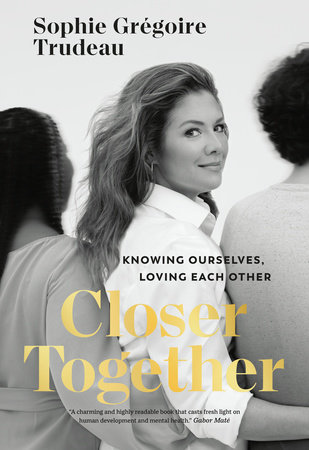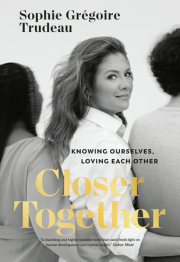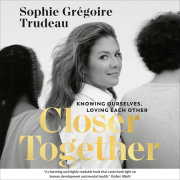INTRODUCTION: HOLDING OURSELVES"Remember always that you have not only the right to be an individual; you have an obligation to be one. You cannot make any useful contribution in life unless you do this." —Eleanor Roosevelt
Let’s start with a tiny confession—there will be more to come. There’s this thing I do every time I find myself standing around somewhere: in a line at the supermarket when someone is taking forever to place their items on the conveyor belt at the checkout, or standing at a function, maybe, or waiting offstage before I’m announced to make a speech. I also noticed myself doing it while I was sitting at my desk for months writing this book (when I wasn’t occasionally doing jumping jacks to get the feeling back into my legs!). It’s subtle—if you looked at me, you wouldn’t even be able to tell, unless you were really observing closely, which I hope you were not! First, I root my feet deeper into the floor, which supports me. Then I try to find where my breath is in my body; I make it deeper and longer, and more spacious in my belly than in my chest. Next, I check if my shoulders are too close to my ears and release them. And last, whether I’m standing upright or sitting in front of the computer, comes the pelvic tilt, where I push my hips a tiny bit forward and bring my tailbone down toward the floor. All of a sudden, I feel more grounded, solid, and calm.
I’ve always been curious about how people inhabit their bodies. As a child, I could effortlessly pick up on facial expressions and cues, any quirks in posture or tone of voice or tics. Once back in the privacy of my bedroom, I would attempt to imitate their stances or movements (surprise, surprise—my kids pick up on the same stuff!). Ever since I studied yoga in my thirties, and became an occasional teacher, I have had a natural, loving desire to adjust the skeletal positioning of human bodies around me. If you’ve ever attended a yoga class and have given consent to hands-on adjustments, you’ll know what I mean. A beautiful assist while you are sitting on your mat: the teacher takes both hands to roll your shoulders back and then elongate your neck by softly lifting up your head. Sometimes that’s all it takes to feel more relaxed, to bring out a sigh of relief.
Did you maybe adjust your own body a tiny bit while reading this?
There’s no question that I am deeply interested in physical alignment, which can offer hints as to mood, health, disease, personality, and energy. The way we walk, sit, or stand can reflect habits, a former injury, and our own fitness level. But I’m also fundamentally and passionately curious about another type of alignment: our unique
emotional alignment. In fact, that’s why I decided to write this book.
As a mental health, emotional literacy, and gender equality advocate for the past two decades, I’ve discovered more about human emotions than I ever thought I would. As much as we are thinking beings, we are
feeling and
sensing beings at our core. Whether we feel happy and hopeful or angry and fearful, we engage not only in a physical or facial expression but also in an emotional posture. Are we truly aware of this process and of how we hold ourselves from the inside? Do we observe, strengthen, and stretch the parts of ourselves, and our minds, that need it the most?
Tell me: If you were to take a snapshot of your mental landscape, what would it look like? Whatever lights and shadows you can discern, whatever moods, emotions, and images, know that they are all part of you. Much of what you’ve seen or felt was wired into what we call your “primitive brain” during childhood, through your relationship with your parent or caretaker. You carried this hardwiring through your childhood and into your teenage years (whether rebellious or not), and through the emotional discoveries you made as you grew into your adult life. We tend to convince ourselves that we are unique—so very different from everyone else around us. But the truth of the matter is that the structure of our brains hasn’t changed in more than two hundred thousand years. Where we differ is in our programming, which is dependent on the care we received, the relationships we foster, and the experiences we live through. As therapist and author Vienna Pharaon explains in
The Origins of You, “understanding your origin wound and the long-standing destructive patterns it leads to will go a long way to addressing conflicts and behaviours that trouble you today.” If you’re doubting that your childhood experiences affect how you come into relationship with others and yourself, then, just like me, you’ll be surprised by what you’ll learn in this book.
Twenty years ago, when I was a young radio and television host in Quebec—a newcomer in my field—I decided to speak out about my struggles with an eating disorder. It wasn’t an easy decision. I was hesitant to show my vulnerability publicly and wondered if I would ever be hired again. No one spoke much about mental health back then, and especially not about eating disorders. But deep down, I felt like it was the right thing to do. I faced my fear and went ahead with it—and it became a turning point that has given my life direction.
Suffering is part of life. We don’t need to avoid or transcend it. Rather, we must develop wisdom, self-reliance, and resilience
through and
with our pain. In our search for happiness, we must uncover its roots, as we carry them with us into our mental state and, therefore, into whatever we do and whomever we come into relationship with. Yale psychology professor Laurie R. Santos, who has studied the science of happiness, found that many of us are working at and doing things that actually put a damper on our level of happy. “Natural selection isn’t into us being happy,” she said in a
Time magazine interview, in which she discussed her own experience with burnout during the pandemic years. “It would prefer we drove ourselves into the ground trying to survive, reproduce, and get the most resources. It’s not in it for joy.”
Think about that for a minute: on a purely neurological level, our brains don’t care if we’re happy.
We need to make that happen, and running ourselves ragged as we chase good grades, status, titles, eternal youth, and bliss isn’t going to do it.
It actually takes courage and work to be happy. We must learn to live with integrity and coherence, staying true to our values and expressing our authentic self. In this way, we can take control over ourselves and our lives. As Dr. Santos says: “Getting out of our own way is the first step to happiness!”
I’m still learning how to get out of my own way. Discovering more about the intricacies of my inner wiring and emotional posture, my childhood, the defence mechanisms I’ve developed, my ongoing longing for safety, and so much more, has allowed me to better understand why I suffered from an eating disorder, how I could heal from it, and how to live with and accept the suffering that had led to it. And along the way, I’m transforming my life—and my brain—with every step.
In November 2022, the world population hit eight billion. That’s eight billion lives, eight billion minds, eight billion hearts. There’s a lot of thinking and feeling taking place on planet Earth.
Unfortunately, the World Health Organization tells us that one out of every eight people suffers from a mental health disorder, and mental health is the single-biggest contributor to years lost at work because of disability. And let’s remember that a healthy mind is not simply the absence of a mental illness. None of us should have to suffer alone.
But before we start pathologizing ourselves, we must also be more aware of the societal structures in which we live. Critical world problems, disparity, gender inequality, climate change, and the incessant flow of news and knowledge being bulldozed our way every day are all examples of environmental factors that can deeply affect our well-being.
It’s time for us to stop spinning and to be more aware of
why we feel and think the way we do, and why so many of us find ways to numb our pain.
Through the years, I’ve had the privilege of meeting people from all walks of life, each with their own unique stories of loss, triumph, heartache, and mind ache. From world-renowned actors, rock stars, writers, and artists to world leaders, queens and kings, Nobel Prize winners, and activists, every being I’ve encountered has their own emotional struggles. And it makes no difference whether they have a big title beside their name or no title at all. I have also observed that we are all one trauma away from each other. The homeless person you pass on the street, for example? That could be you or me after trauma. It takes just a single dramatic life event or a series of smaller traumas to affect our nervous system and brain. This is our shared truth.
My truth is that I’m reaching out to you, in my late forties, as a mother of three, a woman, a friend, a partner, a sister, and a trustworthy, vulnerable, and courageous ally. I want us to take steps and risks together, on our parallel paths, so we can find our light-filled purpose. The goal of understanding and healing ourselves belongs to all of us, and depends on all of us.
British-Canadian physician and psychiatrist Dr. Kwame McKenzie describes
mental health as a term that refers to our emotional, psychological, and social well-being. It affects how we feel, think, and act. Every facet of our lives and every role we have (be it as a child, parent, partner, worker, friend, community member, or elder) is impacted by our mental health. In Canada alone, mental illness costs the country an estimated $50 billion a year. Most people who die by suicide are considered to have mental illness, which also increases one’s risk for diabetes, heart problems, and high blood pressure, to name just a few. “Many people would say that stigma and prejudice are the reasons we do not value mental illness,” Dr. McKenzie says. “The myth is that mental illnesses reflect a character flaw and that we should be able to pull ourselves out of it.”
This myth is a tough one to eradicate. Knowing that, we must work harder at destigmatizing mental disorders by better understanding how we function physiologically and psychologically. In itself, this renewed awareness decreases our stress levels. More of that, please!
This outlook is where the concept of emotional intelligence (known as EQ, or emotional quotient) takes its deepest meaning. Dr. McKenzie tells us that individuals, companies, and countries with high levels of emotional intelligence outperform those with lower levels. But low levels of mental health undermine the ability of both high levels of IQ (intellectual quotient) and EQ to have the desired impact. “‘Mental capital’ is considered a capital because we can invest in it and grow it,” he told me. “It will then act as a resource for us. But if we do not look after it and invest in it, then it could shrink.”
All of the fascinating collaborators I’ve interviewed for this book have worked hard to look after and invest in our shared mental capital. They’ve studied in depth our human capacity for optimized health and psychological flexibility. In these pages, you will meet some of the best and brightest minds in the fields of mental health and well-being: child psychologists, neuroscientists, addiction specialists, relationship experts, artists, mindfulness teachers, and more. I’ve been so blessed to speak with them and have done so with the goal of making their incredible knowledge and insight more accessible to all of us—as it should be. Think about it: we teach our kids how to read and count, but wouldn’t it be nice if they had access at an early age to what I call a “universal emotional library”—a space within themselves that they could draw from when they felt down, confused, angry, or more? This library would hold a common vocabulary and emotional encyclopedia, ready to help us learn more about our emotions and how to sit with our pain in a calmer way. Imagine what kind of world it would be if all the adults you know had a full view of their emotional posture and had learned to regulate their own emotions. That includes you and me. Working in this way toward more self-awareness and compassion would give us greater agency over ourselves and build a collective resilience and a sense of togetherness, which can, in turn, help us confront what we are facing as human beings in this day and age.
This is why I wrote this book; it is my humble contribution to that goal. It takes us on a journey through our emotional landscape—from childhood to adulthood, with some stops in between. It explores why we feel and think the way we do, and the ways in which we can change those feelings and thoughts for the better. Here are just a few of the crucial questions we’ll answer:
• How does our childhood bond of attachment continue to affect us throughout our life, and especially in our relationships?
• What are the challenges of coming of age in our go-go-go culture?
• How can we find our passion and purpose?
• How can knowing ourselves transform our friendships and loving relationships?
• What tools do we have at hand to deal with big emotions and trauma?
• How do sleep, nutrition, exercise, creativity, mindfulness, and a sense of playfulness contribute to our mental health and sense of well-being?
Whether you’re single or married, a teenager or a mid-lifer or older, a parent or not, you are welcomed on this journey. Embark with me. I won’t kid you; it’s going to be an intense ride. But it sure won’t be boring. The warrior and lover in me knows that taking risks and cultivating self-respect is a rebellious, mischievous, and loving act. We must develop more faith in ourselves. But first, we must understand our own emotional history and change the patterns that have come before us, the ones that are holding us back in ways we often don’t even realize. Our world is calling on us to be the breakers of these cycles of negativity!
When I mentioned this idea to bestselling author Terry Real, whom you might have seen on Oprah Winfrey’s show, and whom we will hear more from later, he agreed, saying, “Family pathology rolls from generation to generation, taking down everything in its path, until one person in one generation has the courage to turn to face it. That person brings peace to their ancestors and spares the children that follow. And that’s the work. And beyond that, your family pathology is situated inside a cultural background: the culture of patriarchy, the culture of racism, the culture of misogyny, the culture of toxic individualism.”
We are going to be facing some soft and hard truths together. Get ready. You might feel shocked, surprised, disappointed, sad, or angry, or maybe even inspired and profoundly reassured as you explore your emotional landscape. It doesn’t really matter how you navigate the path that winds through these pages. What counts is that you
feel. Fully. Often, it is when we reach our lowest points that we face our truth. And it hurts. Wherever you are in your life right now, know that every day can be a new beginning. We can rewire our brains and mend our hearts. It’s all possible, but it’s not easy. And it shouldn’t be. But together, we meet in ways that can help us heal and cope, no matter what struggles we are facing individually. And as bestselling author and psychotherapist Esther Perel writes: “The quality of our relationships determines the quality of our lives.”
In a world that is constantly trying to define us, we must know ourselves better in order to resist those pressures and bloom into our authentic selves. Feeling makes us human, and being human makes us feel. Let’s come closer to knowing ourselves so we can love each other better.
Copyright © 2024 by Sophie Grégoire Trudeau. All rights reserved. No part of this excerpt may be reproduced or reprinted without permission in writing from the publisher.







